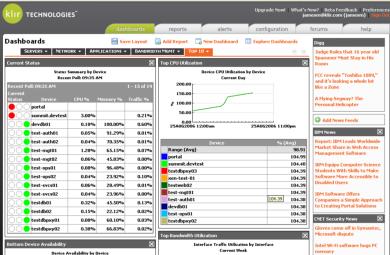The commoditization of systems management

One of the most telling advantages of the on-demand model shows through in the case of applications that depend on multiple external inputs, because the on-demand model allows the vendor to share those input connections across the customer base. For example, take Employease, an on-demand HR management system that handles connections to, amongst other things, benefits claim networks. Each connection to any of those networks is implemented once and then becomes available to all its customers.
What hadn't struck me until a couple of weeks ago when I met with a young company called Klir Technologies is that the same economies of scale apply to systems management. Here's why.
The conventional on-premises approach to systems management — as espoused by the likes of IBM Tivoli, CA-Unicenter, HP OpenView et al — is that the vendor provides agents that interface to each application or class of device in your infrastructure. Each time an application vendor or device maker upgrades the systems management interface on their products, the systems management vendor has to develop and test a new agent and then distribute it to their customers, each of whom implements it.

Klir does things differently and it does so by taking advantage of two things that have changed since those systems management goliaths started doing their stuff in the mid-1990s:
- Instrumentation standards. In the past five years, there have been enormous strides in the finalization and implementation of industry-standard interfaces for systems and application instrumentation. It's not really necessary to deploy agents nowadays, because most of the information you're going to need is actually available through a standard interface on that device that you can just call in a standard way. Of course the established vendors will argue that their agents provide more detailed information than you'll get from those standardized interfaces, but then they have a vested interest in continuing to justify the licensing and deployment costs of an agent-based approach. For the vast majority of IT organizations — and the smaller the organization the more this applies — the information that comes from the standard interface is more than enough. That's why it was defined in the standard, doh! For most corporate environments, agents are an unnecessary added complication.
- Shared services. For every application or class of device that Klir supports, it writes code to query the standard interface developed by the manufacturer, and then it hosts that code in its data center. Because of its shared services architecture, that code is instantly available to all its customers. That's it. No messing about with agents. No deployment delays. It's compelling because you can imagine how many applications and devices there are in the world, and how often a systems management vendor has to develop, distribute and deploy new agents because some application vendor or device maker has decided to upgrade their new systems management interface. Klir's shared services, standard-interface, no-agent model allows it to implement support across its entire customer and prospect base for any new interface, within just a few days of that new interface appearing.
By taking advantage of these two separate developments, Klir has created an IT mananagement application that can be deployed live in as little as thirty minutes, and which costs $10 or less per managed device per month — or free-of-charge (as a try-before-buy offer) for less than 25 devices. On top of that it adds a Web 2.0 style of information sharing that allows all its customers to exchange best practice advice through a shared knowledgebase, which also accesses information from vendor support databases and industry publications.